

Government of Western Australia Department of Justice
To protect, to rehabilitate and to serve
You are here:
Acacia Prison
More information.
- Acacia Prison Contract
- Visiting prisons
- Visits - FAQs

Bookings for social visits have now reopened. Health measures, physical distancing and limits to visitor numbers will apply.
Acacia Prison is a privately-managed prison in Western Australia. The prison is owned by the Department of Justice which contracts management of the prison to an external service provider - Serco.
Acacia's open-plan, campus-style design means prisoners can move around within the complex fairly freely. Prisoners use 'smart card' technology to move within the prison, access their bank accounts and buy goods from the canteen.
Acacia's focus is on rehabilitation and it has a number of industries prisoners can work in including metal work and wood work.
- All visits by appointment only.
- phone +61 8 9573 3300 and select option 1
- Monday to Friday 8.30 am to 11.30 am and 12.30 pm to 3.00 pm
- Friday visit bookings close Thursday 11.30 am
- Saturday bookings close Friday 11.30 am
- Sunday and Monday bookings close Friday 3.00 pm
- The number of visitors per visit is limited to 6 with a maximum of 3 adults.
Visiting times
Friday, Saturday, Sunday and Monday
- 8.00 am to 9.15 am
- 9.40 am to 10.55 am
- 1.00 pm to 2.15 pm
- 3.00 pm to 4.15 pm
Protection only visits
- Monday 9.40 am to 10.55 am
- Saturday 1.00 pm to 2.15 pm
- Sunday 8.00 am to 9.15 am
Official visits
- Tuesday, Wednesday and Thursday - 8.00 am to 11.00 am or 1.00 pm to 4.00 pm
Official visits can also be made via email: [email protected]
All other visits are Mainstream.
Getting there
A free bus service is available from Midland Train Station on Friday, Saturday, Sunday and Monday. The bus service must be booked when the visit is booked as seats are limited.
Buses leave Midland Train Station on:
- Friday, Saturday, Sunday and Monday at 7.15 am, 8.45 am and 2.00 pm
There are no public transport services to the prison.
The cashier is available Monday to Sunday 8.00 am to 11.30 am and 12.30 pm to 3.00 pm, except public holidays.
Cash and EFTPOS available.
Contact details
Acacia Prison Great Eastern Highway WOOROLOO WA 6558 Telephone: +61 8 9573 3300 Facsimile: +61 8 9573 3350
Postal address: Acacia Prison Locked Bag 1 WOOROLOO WA 6558
Page last updated: 23-Jun-2020
About the Department
Adult community corrections, youth justice, rehabilitation and services, victim services.
- Victim-offender mediation
- Victim Notification Register
- General enquiries
- Specific enquiries
Staff Gateway
- DoJ HR Kiosk
- CSD-DoJ HR Kiosk
- Remote access gateway
All contents copyright © Government of Western Australia. All rights reserved. Registered Training Organisation #0843.
- Useful Links
- Accessibility
More results...
146: Inspection of Acacia Prison

Acacia Prison opened in May 2001 and is a medium-security prison for adult males. The facility is owned by the Department of Justice and the operation of the prison has been contracted to the private company, Serco. It is the only privately-operated prison in Western Australia. In 2021, Serco were successful in their bid for …
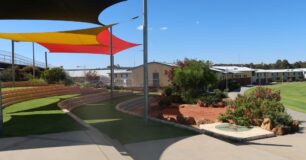
Key findings
In the two years leading up to the inspection, Serco had undergone and won a tender process for a new contract to operate the prison. Once the contract was awarded, Serco developed a transition plan to satisfy the obligations under the new agreement. On 16 May 2021, the State Government acknowledged the achievement of operational …

Last inspection Serco was in a state of uncertainty as to whether it would still hold the contract to manage Acacia after May 2021 when the contract expired. Extensive effort was put into the bidding process and Serco was awarded a new contract for a five-year term with two extension options. With the contract awarded …
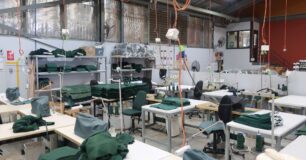
Recommendations
Recommendation 1 Review staffing levels and implement recommended changes to ensure there are adequate staff numbers for the safe operation of the prison. Recommendation 2 Review physical storage capacity and practice and implement recommended changes to safely and securely store prisoner property while eliminating work health and safety risks for staff. Recommendation 3 The Department …
The Government of Western Australia acknowledges the traditional custodians throughout Western Australia and their continuing connection to the land, waters and community. We pay our respects to all members of the aboriginal communities and their cultures, and to Elders both past and present
WATCH: The full horror of what went down in Acacia riot
Never before seen footage from inside a WA prison on the day a major riot unfolded, which caused $10 million damage, can be revealed publicly for the very first time.
A special investigation by The West Australian into the 2022 riot at Acacia Prison can now fully unravel the horror and the terror the brave prison guards would have experienced.
When dozens of inmates at the jail starting lighting fires, smashing the facility and arming themselves with deadly makeshift weapons.
The West recently obtained hours of footage recorded from inside the prison that day.
- About Museum Studies Abroad
- About Our Authors
- About the SRAS Family of Sites

Popular articles
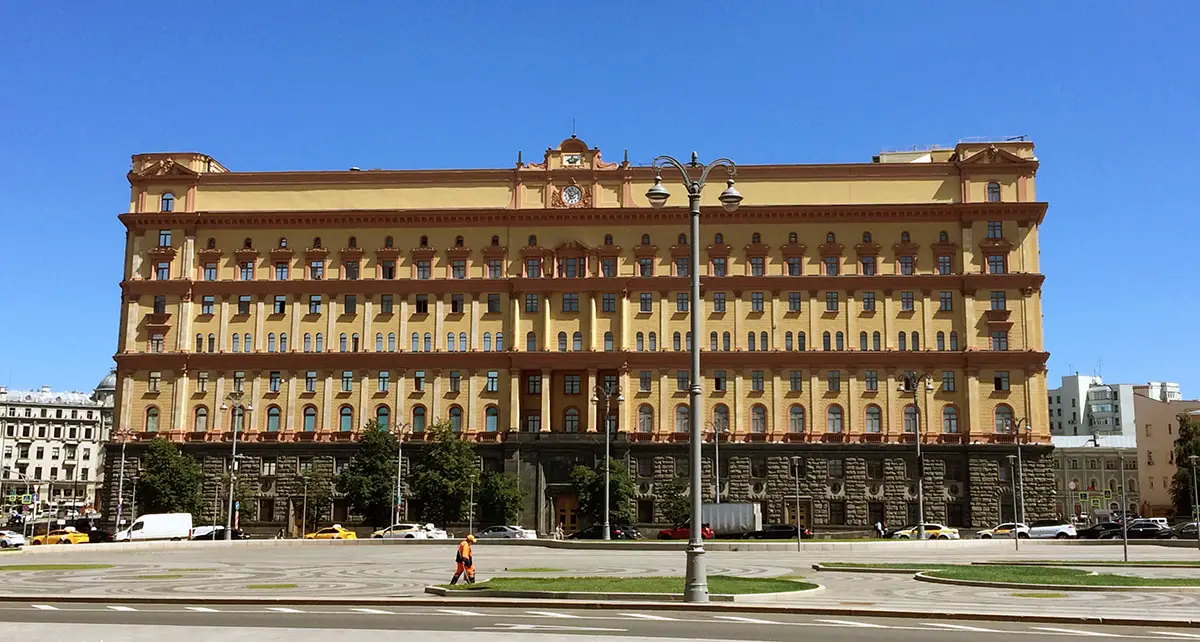
Lubyanka: Inside the Story of Moscow’s Infamous Building and District
Published: June 15, 2021
There is always history surrounding us. In a city like Moscow, this can seem overwhelmingly apparent. Moscow has many imposing buildings from many eras – some are immediately recognizable and others only invite wonder as to what stories lay behind their beauty or grime.
Lubyanka is the name commonly used to refer to the building that has historically housed the security services of the USSR and modern Russia, from the Cheka to the KGB to the FSB. The name has also, for a much longer history, been applied to the adjacent square and surounding neighborhood.
The Lubyanka Building
by Alyssa Rider
The building now known as Lubyanka was originally several buildings.
The two largest were originally designed by Alexander Ivanov and were separated by a street. The largest of these two was built in 1898 and the smaller in 1902 by the All-Russia Insurance Company. Insurance and banking were rapidly growing and profitable industries at that time. Insurance companies would often invest their substantial cash holdings in real estate. Thus, most of the buildings were built as residential and the space was rented for profit.
Perhaps ironically, the original, much more ornate façade of the main building included two female figures representing Justice and Solace.
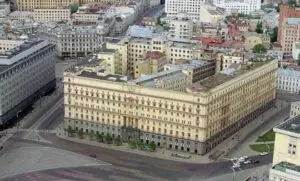
The buildings were seized following the 1917 revolution and became the headquarters for the secret police – the Cheka at the time, though it has served in the same role for the various iterations of the Soviet, and now Russian, state security services – from the OGPU and NKVD, the KGB, and now the FSB.
Lubyanka prison was established in 1920 inside a two story structure adjacent to the main buildings. It had originally been a hotel built, again, by the All-Russia Insurance Company. It was soon expanded to six floors. Jokes referred to it as the “tallest building in Moscow,” as one could purportedly see Siberia (and the Gulag system) from its basement, as that was the fate that awaited most that saw the inside of the prison’s walls.
In 1940, Aleksey Shchusev was commissioned to enlarge the complex to accommodate the increasing amount of staff required to handle the Great Purge. The staff had grown from 2,500 in 1928 to nearly 34,000 in 1940.
An extra floor was added, and the main building expanded horizontally, consuming and incorporating nearby buildings. This expansion was interrupted by the Nazi invasion, leaving the facade lopsided until it was completed under the orders of Yuri Andropov in the 1980s.
The building now contains FSB headquarters, a group of holding cells, the headquarters of the Border Guard Service, and two museums: one devoted to the KGB/FSB and one dedicated to the old prison (neither is actually open to the public).
The Museums Inside the Lubyanka Building
The museums offer regularly updated exhibits, both historical and modern. The Museum of the KGB, now known as the Historical Demonstration Hall of the FSB of Russia, is located inside the Lubyanka complex, and contains four rooms and over two thousand exhibits.
Exhibits cover the history of Russian and Soviet counterintelligence, and there are documents from the times of both Peter and Catherine the Great, as well as the Napoleonic War and WWI. There are separate stands with information on events relating to mass repressions, as well as a room dedicated to WWII. The museum also includes a significant amount of technical equipment that has been used for reconnaissance and counterintelligence purposes, as well as more recent documents relating to FSB operations.
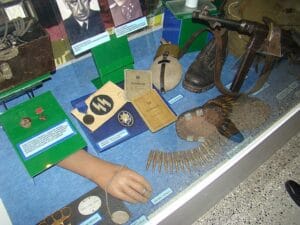
The prison museum has never been open to the public and is maintained only for FSB personnel and high-ranking government officials. The “Demonstration Hall” was opened to the public in 1989. Accessing it was still difficult, as it is located inside the FSB complex and tours were offered almost exclusively through private tour companies and only after screening potential visitors. In recent years, the tours became rarer and today this museum, too, is officially closed to outside visitors.
Lubyanka: Fountain, Statue, or Abstract Nothing?
The names were not the only thing that changed. In 1835, a fountain was installed on the square. This fountain was called Nikolsky Fountain (its name borrowed from the same gates mentioned above), and was designed by the Italian sculptor Giovanni Vitali and supplied potable water to the neighborhood.
Nikolsky Fountain is one of the oldest in Moscow, and it still stands, but no longer on Lubyanka. It was moved in the 1930s to a new location in the courtyard of Alexandrinsky Palace in Neskuchny Garden, part of the Gorky Park complex in central Moscow.

In 1958, a 15-ton iron statue of Dzerzhinsky, known as “Iron Felix” was installed in its former place on Lubyanka. This statue, in turn, was toppled in a public demonstration after the fall of the Soviet Union. It was transferred by the Russian Academy of Arts to the Muzeon, also known as Fallen Monument Park, to be joined by many other Soviet statues removed or toppled at that time.
In 2017, a general renovation of Lubyanka and the surrounding traffic patterns was announced by the city. It was debated if the fountain or even Iron Felix should be brought back. In the end, however, the space was enlarged and landscaped with flat, circular geometric shapes. The space, used and undecorated, remains largely unused.
In 2021, another effort to bring back the statue was proposed by the modern Communist Party in Moscow. The mayor initially agreed to allow the issue to be voted on in a referendum, but soon reversed his decision and killed the initiative.

The Solovetsky Stone
The Solovetsky Stone is a monument located across the street from Lubyanka Square in a separated area known as Musuem Park. It was created in commemoration of the political prisoners who were repressed under the GULAG system.
The Solovetsky Stone is a large granite block brought from the Solovetsky Islands, where the Solovetsky Special Purpose Camp operated in the 1920s and 1930s as part of the GULAG system. It was officially opened on October 30, 1990.
Founding such a memorial had become a matter of public discussion a few years earlier, in the late 1980s. The Memorial Society, now a globally-respected NGO, began a petition with the goal of creating a monument of political repression in 1987, and in 1988, a Public Council for the creation of such a monument was formed. A contest was also held in 1988, wherein people could submit their monument ideas and suggest locations, but a winner for this contest was never chosen.

The specific stone idea came from a memorial created in the village of Solovetsky in 1989 by former Solovetsky prisoners, many of whom stayed there after their release, and members of the Memorial Society. Members of the Society from Arkhangelsk, St. Petersburg, and Moscow liked the idea so much that they acquired boulders to place in their own cities.
The opening of the Moscow memorial on served as a triumph not only in its own right, but also marked the first official recognition of the Day of Victims of Political Repression since that day began to be recognized by dissidents in 1974. Every year on this day, people now gather near the Solovetsky Stone to mourn. Since 2007, a practice called the ‘Return of Names’ has taken place on the 29th from 10 AM to 10 PM – people from across the city gather in a long line to take turns reading the names of Muscovites who were executed. Similar actions take place in many other cities and even other countries, on this day or the next.
The Solovetsky Stone has also become an unofficial site for civil protest, serving not only as a memorial but as a symbol for modern-day political dissonance.
You Might Also Like

Russian Protest Art that Isn’t Pussy Riot
When most think of Russian protest art today, they think immediately of Pussy Riot, the long-famous, all-female punk movement. These women have, since their “punk prayer” launched them to international notoriety, been heavily covered in the English-language press and heavily studied in English-language academia. However, Russian protest art is a diverse genre with a long […]

The Muzeon and Art Market
Across the street from Gorky Park, on the territory of the New Tretyakov Gallery and the Central House of Artists lies Sculpture Park, which is known as “Muzeon” to locals. It is most famous as a graveyard of Soviet era statues, but also contains much modern art and several themed, sculpted landscapes all in an […]
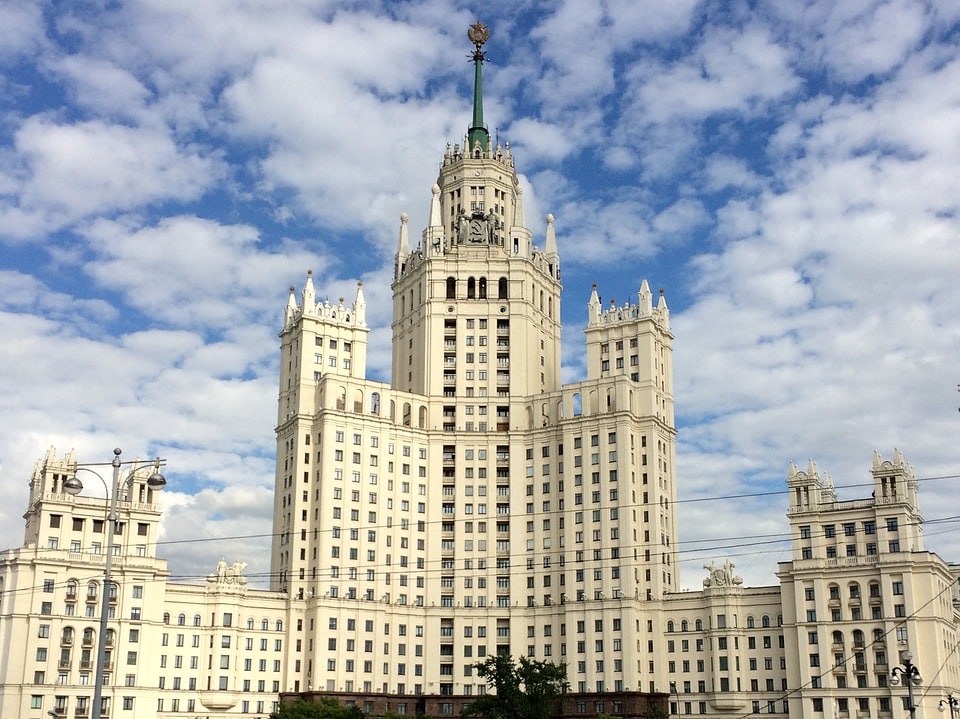
The State Museum of Political History of Russia
Centrally located in St. Petersburg, the State Museum of Political History of Russia examines Russia’s tumultuous political history. It does so in a way that is both modern and quite balanced. Exhibits in the main building are shown in an attractive, recently-renovated tsarist-era mansion with modern technology and artful multimedia presentations. Exhibits give a wide […]
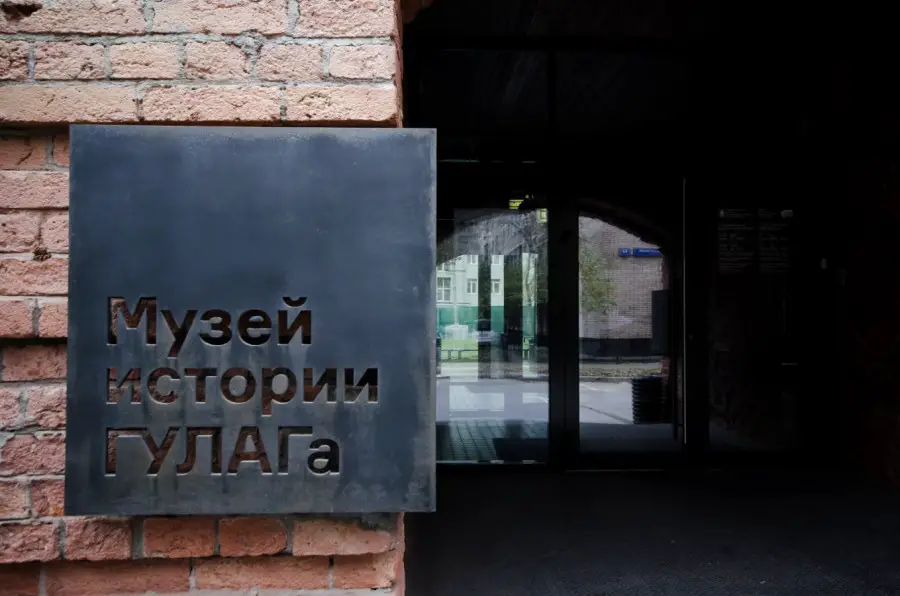
GULAG History Museum
Excursion included in SRAS cultural program for Moscow for Fall, 2017. The GULAG Museum, established in 2001 by writer, historian, and former gulag prisoner A.V. Antonov-Ovseenko, is the only state museum devoted to Stalin’s repressions and the GULAG system. We took a guided tour of this small but informative museum as part of our SRAS […]

About the authors

Katheryn Weaver
Katheryn Weaver is a student of rhetoric and history at the University of Texas, Austin. Her primary areas of investigation include revolution and the rhetorical justification of violence against individuals, state, and society. She is currently studying Russian as a Second Language with SRAS's Home and Abroad Scholarship.
Program attended: Home and Abroad Scholar
View all posts by: Katheryn Weaver

Alyssa Rider
Alyssa Rider, at the time she wrote from this site, was a rising senior at Brandeis University in Waltham, Massachusetts, majoring in Russian Studies and International/Global Studies with a minor in History. She planned to study abroad in Dublin, Ireland, in the fall, to study Russian, as well as a few other things. While she first became interested in Russia because of the language, she also developed an interest in LGBTQ rights in Russia. She also hoped to work as a translator.
Program attended: Online Interships
View all posts by: Alyssa Rider
- Bahasa Indonesia
- Slovenščina
- Science & Tech
- Russian Kitchen
Butyrka: Moscow's oldest prison
.jpg)
At the end of the 18th century, the prison became known as “Butyrka prison fortress”. Source: Lori / Legion Media
A job for Houdini
The word around Moscow is that it is impossible to escape from Butyrka, an impregnable prison located north of the city center. So the gauntlet was well and truly down for great illusionist Harry Houdini, who came here in 1908 to show off his skills.
Stripped bare, in manacles and fetters, he was shut up in the prison’s most inescapable apparatus, a metal box used to transport convicts to Siberia.
28 minutes later, Houdini emerged from the box. But although he may be the best-known, Houdini was just one of Butyrka’s celebrities.
Founded in 1771, Butyrka housed Russia’s most dangerous criminal of the time – Yemelyan Pugachev, a Cossack leader of the great peasant rebellion. Butyrka witnessed Pugachev's last night before execution , and preserved his memory for long afterwards .
The vertical cage in which Pugachev was forced to stand upright for days was kept in the inner yard of the prison for a hundred years along with his 22-pound fetters, and the tower where he was incarcerated still bears his name.
Convict at the helm
At the end of the 18th century, the prison became known as “Butyrka prison fortress” – it was rebuilt into a real castle with four towers and a fortress wall. Butyrka became a transit prison: each year, 30,000 convicts left here on their way to country jails and exile.
One group of exiles marching from Butyrka to the central railway station had an unusual companion – Count Leo Tolstoy, who later described this journey in his novel “Resurrection”.
In 1917, Felix Dzerzhinsky, the future head of the Soviet State Security forces, was kept in Butyrka as a dangerous revolutionary. Cut off from the outside world in a solitary cell, he was unaware of the ongoing revolution.
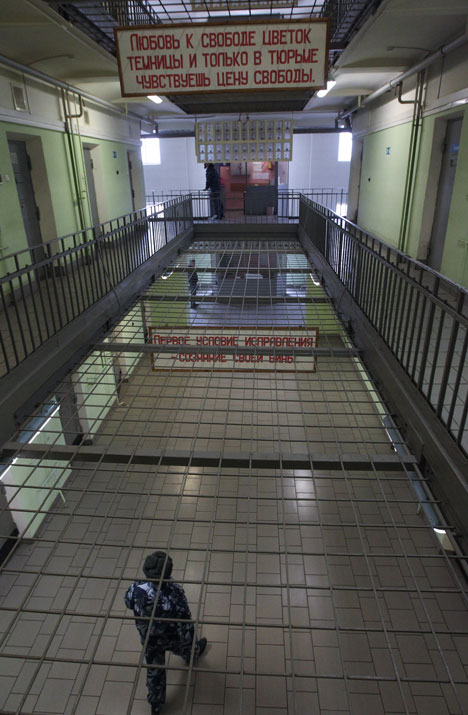
The love of freedom is the flower of the prison, and only in prison you feel the price of freedom, the poster above says. Source: RIA Novosti
But on 27 February he was set free by a group of women and schoolboys who had come to Butyrka to free political prisoners. After the October Revolution, Dzerzhinsky, who was already familiar with prisons from the inside, became one of the chief architects of Soviet repressions, and he took great care to ensure that prisons, and Butyrka in particular, were well guarded to keep the enemies of the new state out of sight.
“Butyrka’s security must be improved: no communication between cells, no walks in corridors, no meetings,” Felix wrote. But in the early Soviet years, Butyrka became so overcrowded that even the strict regime and dire conditions couldn’t stop inmates from leading an active social life behind prison walls.
Jailhouse rock
The conditions in early Soviet prisons were appalling. An investigation officer recalled that upon entering the cell, he commanded everybody to stand in the opposite corner – otherwise, the inmates would bombard him with lice from behind.
More than 40 percent of the convicts were sentenced to less than a year for minor offenses, so their worldview was not grim – and in prison, they were fed every day, a luxury for many in those needy times. Even in these conditions, the demand for culture persisted .In the 1920s, prisons became filled with educated people: members of the intelligentsia as well as dissident communists who were against Bolshevik policies. Many of them loved art and
In the 1920s, prisons became filled with educated people: members of the intelligentsia as well as dissident communists who were against Bolshevik policies. Many of them loved art and entertainment, and continued to pursue their passion even in the cells.
While former civil statesmen, scorned both by convicts and guards alike, cleaned up the lavatories and swept floors, the convict communists in neighboring cells would strike up revolutionary hymns, former Tsarist colonels made lectures on World War I, and even a prison theater was organised in some cells.
Sometimes, professional singers would also get arrested – and in prison they found the recognition they had yearned for as free men. Sticking their heads through the bars of their cells overlooking the prison yard, they would sing to deafening applause from all over the prison.
In 1920, legendary singer Fyodor Chaliapin also performed in Butyrka. Tap dancing was very popular among convicts, especially burglars and robbers, and in prison, they had the chance - and a lot of time - to learn sophisticated moves from experienced cellmates.
Prison next door
Before the 1980 Moscow Olympics, the authorities decided to conceal Butyrka from the inquisitive eyes of the city’s guests, so an apartment building was built around it. But the presence of the prison was always felt in the neighborhood.
If a young man was walking along the street past the windows of the women’s section, lonely convicts would yell: “Hey handsome, stop for a second, just so we can look at you.” Meanwhile, sad, grey-faced people would line up for meetings with inmates at the visitors’ entrance, next door to the department store, ironically called “Youth”.
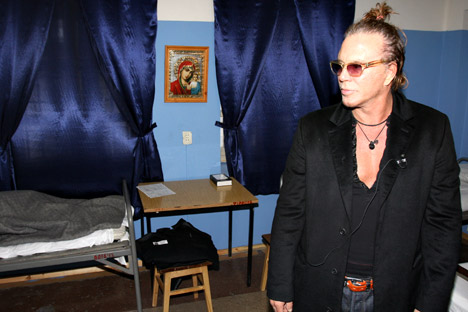
Mickey Rourke visited Russian prison in 2009. Source: ITAR-TASS
In the 1990s, Butyrka witnessed some spectacular escapes. In 1996, the first breakout by a woman in the prison’s history took place: 26-year-old Natalya S. took the place of her cellmate, who was due to be released, and walked freely out of the compound.
It was easy for the women to swap places, as they all looked similarly worn out and drained. Still, Natalya was caught three days later. In 2010, a young thief pushed away his escort during a walk, and leaped over the high barbed-wire fence like an Olympic vaulter. The offender wasn’t captured.
Chronicles of Russian Alcatraz: Vladimirsky Central turns 230
Butyrka’s fame has even spread abroad. In 2009, Mickey Rourke, preparing for the role of Whiplash in “Iron Man 2”, visited Butyrka – his Russian character had a criminal past, so Rourke wanted to know what Russian prisons were like on the inside.
Rourke visited the cells and tasted the prison soup and bread baked by inmates, which he liked the most. In the prison museum, he tried on an 18-century torture device – a spiked metal collar that wouldn’t let a prisoner sleep.
No one except Rourke ever put on this thing voluntarily – even the diehard inmates were impressed.
All rights reserved by Rossiyskaya Gazeta.
to our newsletter!
Get the week's best stories straight to your inbox
This website uses cookies. Click here to find out more.
- Azerbaijani
- Chinese (Simplified)
- Chinese (Traditional)
- Haitian Creole
- Kinyarwanda
- Kurdish (Kurmanji)
- Kurdish (Soranî)
- Odia (Oriya)
- Scots Gaelic
Hakea Online Visitors Booking Form
Important information for visitors Social visits are not available on Tuesdays or Thursdays. Please be aware that social visits may be temporarily suspended if there are high numbers of COVID-19 cases at a facility.
Visitor booking help
For assistance with booking a visit, phone 6 18 9366 6333, Monday to Friday, 8.00 am to 4.00 pm (excluding Public Holidays).
Social Visits
- Social visits are not available on Tuesdays or Thursdays
- No more than 4 social visitors per table, inclusive of:
- Minimum of 1 adult and up to 3 children. OR
- Maximum of 2 adults and up to 2 children.
- No more than 3 Adults permitted for an E-Visit.
- There is no limit on the number of children permitted for an E-Visit.
- E-Visits are available Monday, Wednesday and Friday from 3.00 pm to 4.00 pm.
Provided by
Hakea Prison Address: Hakea Prison Nicholson Road CANNING VALE WA 6155 Postal address Locked Bag 111 CANNING VALE WA 6970 Telephone: 61 8 9366 6333
- Facebook share (Opens in a new tab/window)
- Twitter (Opens in a new tab/window)
- LinkedIn (Opens in a new tab/window)
What did you like about it?
Don't include any personal information. If you need a response, send an enquiry instead.
How can we make it better? *
Acknowledgement of country.
The Government of Western Australia acknowledges the traditional custodians throughout Western Australia and their continuing connection to the land, waters and community. We pay our respects to all members of the Aboriginal communities and their cultures; and to Elders both past and present.

IMAGES
VIDEO
COMMENTS
Acacia Prison is a privately-managed prison in Western Australia. The prison is owned by the Department of Justice which contracts management of the prison to an external service provider - Serco. ... Official visits can also be made via email: [email protected]. All other visits are Mainstream. Getting there. A free bus ...
The Prison is owned by the Department of Justice which contracts management of the prison to Serco. Acacia's focus is on rehabilitation and it has a number of industries prisoners can work in including metalwork and woodwork. ... For more information or to book an official visit email [email protected]. Official visits are ...
Select a prison or detention centre for information and how to book a visit: Acacia Prison. Albany Regional Prison. Bandyup Women's Prison. Banksia Hill Detention Centre. Boronia Pre-release Centre for Women. Broome Regional Prison. Bunbury Regional Prison. Casuarina Prison.
Acacia Prison. Street address: Great Eastern Highway, WOOROLOO WA 6558. Postal address: Acacia Prison, Locked Bag 1, WOOROLOO WA 6558. Telephone: +61 8 9573 3300. Email: [email protected]. More information on visiting Acacia Prison. Freedom of Information Statement.
The prison was opened in May 2001. Acacia was the first privately managed prison in Western Australia and was managed by Australian Integration Management Services Corporation (AIMS Corp) for its first five years of operation. Serco began managing the prison in 2006. The prison employs over 300 custodial officers and more than 200 non-custodial ...
Over the past two months, there have been more than 4400 e-visits conducted across 16 prisons and the youth detention centre. The privately-operated Acacia Prison has also facilitated e-visits for inmates. In the absence of face-to-face visits, the services have enabled prisoners to see and talk to family, friends and even pets online.
Acacia Prison is located on Whadjuk Noongar land in the suburb of Wooroloo, Perth, Western Australia. The facility is a medium-security prison for adult males. Acacia Prison opened in May 2001. The facility is owned by the Department of Justice and the operation of the prison has been contracted to the private company, Serco.
71: Report of an announced inspection of Acacia Prison. 17 May 2011 Inspection. Acacia Prison was the State's first privately run prison. This inspection concluded that: 'Acacia's performance is at least equal to the best public sector prisons in the State and in many respects it is superior'. Download 1.03 MB View Details.
Acacia Prison opened in May 2001 and is a medium-security prison for adult males. The facility is owned by the Department of Justice and the operation of the prison has been contracted to the private company, Serco. It is the only privately-operated prison in Western Australia. In 2021, Serco were successful in their bid for ….
WATCH: The full horror of what went down in Acacia riot. Never before seen footage from inside a WA prison on the day a major riot unfolded, which caused $10 million damage, can be revealed publicly for the very first time. A special investigation by The West Australian into the 2022 riot at Acacia Prison can now fully unravel the horror and ...
Corrective Service leaders honoured. Congratulations to the Department of Justice recipients of the King's Birthday 2024 Honours List (Meritorious Awards) Australian Corrections Medal. The Medal recognises outstanding and distinguished service by member of an Australian state or territory civilian corrections service for adults.
Visits are so important to prisoners ,it is just so fucken worth getting through all the bullshit today to day prison life for that brief hour. Acacia ain't to bad in the scheme of things ,Casuarina is by far the worst.
Acacia Prison in lockdown, 24 hours after guards were forced to shelter from a wild riot.100 inmates turned violent, setting fires as they scaled the roof in...
Lubyanka prison was established in 1920 inside a two story structure adjacent to the main buildings. It had originally been a hotel built, again, by the All-Russia Insurance Company. ... A visit to the GULAG History State Museum finished the day off with a multimedia experience concerning the history that played out, in part, inside those ...
Lubyanka (Russian: Лубянка, IPA: [lʊˈbʲankə]) is the popular name for the building which contains the headquarters of the FSB on Lubyanka Square [1] in the Meshchansky District of Moscow, Russia. It is a large Neo-Baroque building with a facade of yellow brick designed by Alexander V. Ivanov in 1897 and augmented by Aleksey Shchusev from 1940 to 1947.
Alexei Navalny will spend his 47th birthday Sunday in a tiny prison cell with hardly any natural light. He won't be able to see or talk to loved ones because phone calls and visits are banned for those in "punishment isolation." Prison guards usually blast patriotic songs and speeches of President Vladimir Putin at him. He's serving a nine-year term due to end in 2030 on charges widely ...
The Acacia Prison annual report highlights the prison's significant events and activities for the financial year, including performance measures outcomes and compliance. These reports are tabled in Parliament pursuant to s 15G of the Prisons Act 1981. For further information refer to Acacia Prison.
The historic prison's walls have many stories to tell, including the visits of Leo Tolstoy and Harry Houdini. At the end of the 18th century, the prison became known as "Butyrka prison fortress ...
Hakea Online Visitors Booking Form. If you are new Social visitor, a Declaration must be completed at the prison prior to your visit. Please ensure that you bring with you a valid photo ID and arrive at the prison 30 minutes before the visit to establish your identification. Last updated: 20 March 2024.